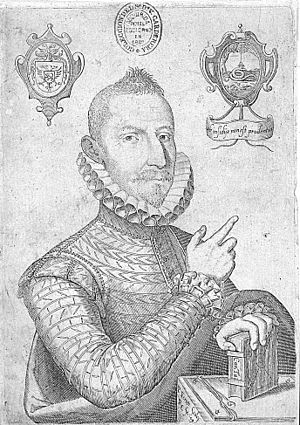Mateo Alemán facts for kids
Quick facts for kids
Mateo Alemán
|
|
|---|---|

Retrato de Mateo Alemán (1599)
|
|
| Born | September 1547 |
| Died | 1614 (aged 66–67) |
| Alma mater |
|
| Occupation | Writer |
|
Notable work
|
Guzmán de Alfarache |
| Signature | |
 |
|
Mateo Alemán y del Nero (born September 1547, died around 1615) was an important Spanish novelist and writer. He is best known for his famous book, Guzmán de Alfarache.
A Spanish Writer's Life
Mateo Alemán was born in Seville, a city in Andalucía, Spain. He finished his studies at the University of Seville in 1564. Later, he continued his education at other well-known universities, including Salamanca and Alcalá.
From 1571 to 1588, Mateo Alemán worked in the government's treasury department. In 1594, he faced some financial problems and was briefly held, but he was quickly released.
In 1599, Mateo Alemán published the first part of his most famous book, Guzmán de Alfarache. This book was a huge success! It was a type of story called a picaresque novel. This means it followed the adventures of a clever but often mischievous hero who travels around and experiences many different parts of society. The book was so popular that it had sixteen different printings in just five years. Someone even tried to publish a fake sequel in 1602, but the real second part of his story didn't come out until 1604.
Mateo Alemán's personal life had its challenges. He married Catalina de Espinosa in 1571, but their marriage was not a happy one. He also often struggled with money. In 1602, he was jailed in Seville because of his debts.
Around 1608, Mateo Alemán moved to America. He is believed to have worked as a printer in Mexico. He likely stayed there for the rest of his life. In 1609, he published a book in Mexico called Ortografía castellana. This book had smart and helpful ideas for how to improve Spanish spelling. There are no records of Mateo Alemán after 1609, but some people think he might have lived until 1617.
Mateo Alemán's Famous Books
Besides his well-known novel, Mateo Alemán also wrote other works. In 1604, he wrote a book about the life of Saint Anthony of Padua. He also translated two poems by the Roman poet Horace, which showed his good taste and skill with words.
However, his most famous work is definitely Guzmán de Alfarache. This novel was so popular that it was translated into many languages. It was translated into French in 1600, Italian in 1606, German in 1615, and English in 1622 by a translator named James Mabbe. It was even translated into Latin in 1623! This shows how important and widely read his work was during his time.
Images for kids
See also
 In Spanish: Mateo Alemán para niños
In Spanish: Mateo Alemán para niños


